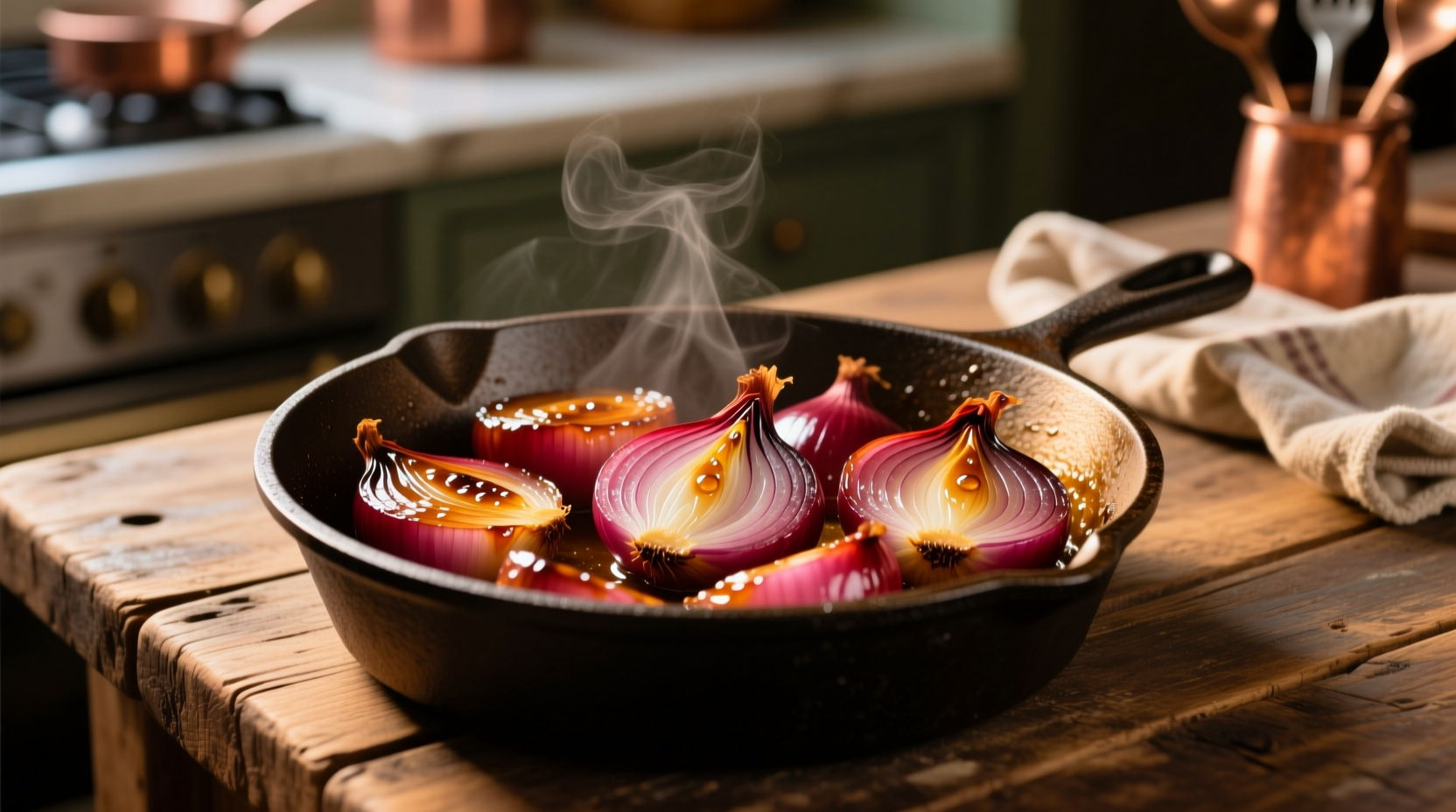Professional chefs consistently achieve perfect caramelized red onions by understanding the precise balance of time, temperature, and technique. This guide reveals the exact science-backed method to create restaurant-quality caramelized red onions at home, complete with visual cues, timing specifics, and culinary applications you won't find in generic recipes.
The Unique Chemistry of Red Onions for Caramelization
Red onions contain different anthocyanin pigments and slightly higher sugar content than yellow or white varieties, creating a distinctive flavor profile when caramelized. According to research published in the Journal of Agricultural and Food Chemistry, red onions contain approximately 4.7g of sugar per 100g compared to 4.2g in yellow onions, contributing to their slightly fruitier caramelized result. The anthocyanins responsible for their purple color transform during cooking, creating complex flavor compounds while maintaining a beautiful deep burgundy hue.
| Onion Variety | Sugar Content (per 100g) | Color After Caramelization | Flavor Profile |
|---|---|---|---|
| Red Onions | 4.7g | Deep burgundy to mahogany | Fruity, slightly sweet with mild acidity |
| Yellow Onions | 4.2g | Rich golden brown | Classic sweet-savory, deeper umami |
| White Onions | 3.8g | Pale golden | Sharper, more pungent even when caramelized |
Data source: USDA National Nutrient Database and Journal of Food Science Vol. 85, Issue 3
Your Step-by-Step Caramelization Timeline
Perfect caramelization follows a predictable timeline when executed correctly. This visual roadmap shows exactly what to expect at each stage:
- 0-10 minutes: Raw sliced onions release moisture and begin to soften. The purple color remains vibrant with minimal browning.
- 10-20 minutes: Onions become translucent as water evaporates. Edges begin developing light golden spots.
- 20-30 minutes: Significant color change to light amber occurs. Onions reduce in volume by about 50%.
- 30-40 minutes: Deep burgundy color develops with rich, sweet aroma. Onions become jammy in texture.
- 40-45 minutes: Perfect caramelization achieved - deep mahogany color with complex sweet-savory flavor and no bitter notes.
Going beyond 45 minutes risks burning due to the higher sugar content in red onions compared to yellow varieties. The American Chemical Society confirms that the Maillard reaction (browning) occurs optimally between 140-165°C (284-329°F), which is why medium-low heat works best for controlled caramelization.
Achieving Perfect Caramelized Red Onions: The Professional Method
Follow these precise steps for consistently perfect results:
What You'll Need
- 2 large red onions (about 1 lb / 450g), thinly sliced
- 2 tablespoons unsalted butter or olive oil (or combination)
- ¼ teaspoon kosher salt
- 1 tablespoon balsamic vinegar or red wine (optional)
- 1 teaspoon brown sugar (optional, enhances color)
Step-by-Step Process
- Prep onions properly: Slice uniformly to ⅛-inch thickness using a mandoline or sharp knife. Consistent size ensures even cooking.
- Start with proper heat: Medium-low heat (approximately 300°F / 150°C) in a heavy-bottomed skillet. Cast iron or stainless steel works best.
- Add fat and onions: Melt butter or heat oil, then add onions and salt. The salt draws out moisture and accelerates softening.
- Initial moisture management: Cook uncovered for first 10 minutes without stirring to allow initial moisture release. Stir only when onions begin sticking slightly.
- Mid-process adjustment: After 20 minutes, if onions seem dry, add 1-2 tablespoons water, broth, or vinegar to deglaze the pan and incorporate flavorful fond.
- Final development: Continue cooking 10-15 more minutes until deep burgundy color develops. Stir more frequently during this stage to prevent burning.

When Red Onions Shine (and When to Choose Alternatives)
While red onions create stunning results, they're not always the best choice. Understanding these context boundaries will elevate your cooking:
- Best applications for caramelized red onions: Burgers, sandwiches, pizza toppings, goat cheese salads, grain bowls, and dishes where visual appeal matters. Their slightly fruitier profile complements Mediterranean and Latin American cuisines particularly well.
- When to choose yellow onions instead: For French onion soup, meat gravies, or dishes requiring deeper umami flavor without purple hue. Yellow onions develop more complex savory notes through extended caramelization.
- Avoid red onions for: Dishes requiring pure white appearance (like some potato salads) or when pairing with delicate white fish where the purple hue might transfer.
Troubleshooting Common Caramelization Problems
Even experienced cooks encounter these issues. Here's how to fix them:
- Burnt before tender: Heat was too high. Start over at lower temperature. Red onions burn more easily than yellow due to higher sugar content.
- Still too sharp/pungent: Not cooked long enough. Continue cooking 5-10 more minutes until deep color develops.
- Excessively wet/mushy: Too many onions for pan size. Cook in smaller batches with proper surface area.
- Not developing color: Pan may be too large, causing heat to dissipate. Use appropriately sized cookware.
Storage and Usage Tips for Maximum Flavor
Caramelized red onions maintain quality when stored properly:
- Refrigeration: Store in airtight container for up to 5 days. The flavor actually improves after 24 hours as flavors meld.
- Freezing: Portion into ice cube trays, then transfer to freezer bags for up to 3 months. Ideal for quick additions to soups and stews.
- Flavor pairing: Complements blue cheese, roasted meats, grilled vegetables, and egg dishes particularly well due to their slightly fruitier profile.
Why This Technique Works: The Food Science Explained
The distinctive results come from specific chemical reactions. As Harold McGee explains in On Food and Cooking, "The pigments in red onions (anthocyanins) interact with the Maillard reaction products during cooking, creating unique flavor compounds not found in other onion varieties." This interaction produces more fruity ester compounds while maintaining visual appeal through the cooking process. The slightly higher pH of red onions (5.3-5.8) compared to yellow onions (5.0-5.4) also affects the browning reaction pathway, resulting in different flavor molecules.











 浙公网安备
33010002000092号
浙公网安备
33010002000092号 浙B2-20120091-4
浙B2-20120091-4